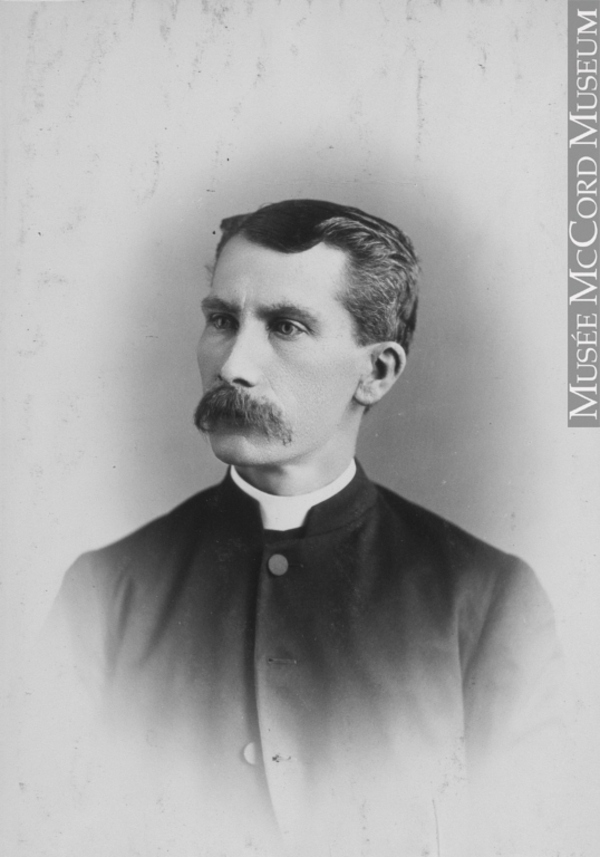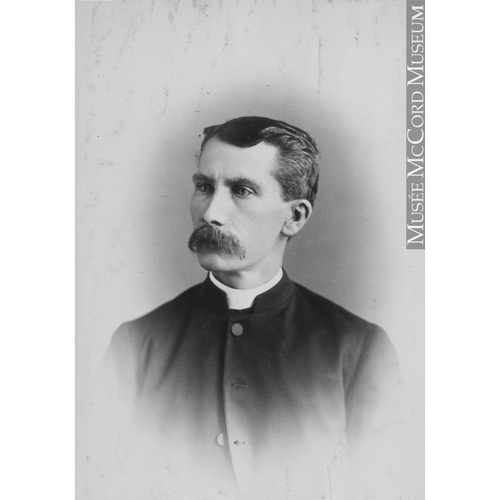
Source: Link
Thorneloe, George, Church of England clergyman and archbishop; b. 4 Oct 1848 in Coventry, England, son of James Thorneloe and Katharine Carter; m. 18 Aug. 1874 Mary Eliza Fuller (d. 28 Jan. 1921) in Lennoxville (Sherbrooke), Que., and they had a son and a daughter; d. 3 Aug. 1935 in Sault Ste Marie, Ont.
George Thorneloe’s father immigrated in 1856 to Lower Canada, where he was received on trial as a Wesleyan Methodist missionary at Granby in 1858, the year his wife and two sons joined him. He was ordained in 1861 but later reverted to the Anglican faith in which he had been raised. Priested in 1868, he was appointed rector of the parish of Georgeville, Que., and subsequently ministered in Montreal.
George was educated at Bishop’s College, Lennoxville. He had a long association with this institution, from which he graduated in 1872 with first-class honours in classics (ma 1877), where he studied divinity under Henry Roe*, among others, and where he later taught in combination with parish work. He would act as an examiner for the university from 1884 to 1896, serve on its council from 1889 to 1896, and be the university preacher in 1890. Ordained a deacon in 1874, Thorneloe was raised to the priesthood the following year. He carried out a successful ministry first at Stanstead and then, from 1885, at St Peter’s, Sherbrooke. In addition, he became active in wider church affairs: he was made a canon of the Cathedral of the Holy Trinity in Quebec City in 1888 and would become clerical secretary of the synod of the ecclesiastical province of Canada in 1895.
Thorneloe was nominated, but not elected, as bishop of Quebec in 1892 on the death of James William Williams*, and as bishop of New Westminster, B.C., two years later. In 1896 he was chosen by the synod of the ecclesiastical province of Ontario to succeed Edward Sullivan* as missionary bishop of Algoma, a position he would hold for the next 30 years. He was the third bishop of this diocese, which had been founded in 1872 and was first served by Frederick Dawson Fauquier*.
The diocese of Algoma stretches from west of Thunder Bay east to the Quebec border and from the watershed northwest of Lake Superior south through the Parry Sound and Muskoka districts to the diocese of Toronto. Since its beginnings in the 1830s, Anglican ministry in this area had centred on itinerant missionary work among First Nations [see William McMurray*; Frederick Augustus O’Meara*]. Thorneloe’s election in 1896 came just at the start of a sustained increase in the non-indigenous population with the creation of communities brought about by the building of railway lines and the development of mining, forestry, and agriculture. These changes redirected the focus of Anglican endeavours, which now shifted to the needs of the recent arrivals, the establishment of parishes, and the construction of church buildings on the familiar model of the more settled portions of southern Ontario. Work among First Nations continued, but much of the energy and money available for this ministry was absorbed when the diocese took over from the Colonial and Continental Church Society the maintenance of the Shingwauk Industrial Home in Sault Ste Marie [see Edward Francis Wilson*].
Thorneloe provided able and productive leadership in the substantial growth of the Anglican church in the region. He undertook exhausting travels – on foot, by canoe, by horse and buggy or sleigh, and increasingly by train – to christen, confirm, convert, and consecrate, always aware of “the keen competition of other bodies of Christians”; in 1914 he would report that he had journeyed 30,000 miles in the preceding three years. In 1906 he shepherded Algoma in its transition from a missionary diocese administered by the provincial synod to a self-governing diocese with its own synod and the right to elect its bishop. He revived the Algoma Association in England, which raised considerable funds for missionary work. With its aid he succeeded in paying off the large debt that he had become responsible for on taking office, an obligation he described as “an inheritance of woe.”
During his years in Algoma, Thornloe was elected bishop by synods in the dioceses of Ontario, in 1900 [see William Lennox Mills*], and Ottawa, in 1914, but he preferred to remain at his post. He was also nominated for the bishopric of Nova Scotia in 1904, and five years later he found himself in a tight race with Henry John Cody* for the see of Toronto even though he had not consented to his nomination (in the end a compromise candidate was chosen). The Ottawa election was particularly difficult for him. After Charles Hamilton, the diocese’s first bishop, retired in 1914, a synod was called to choose his successor. The metropolitan of the province usually chairs such diocesan elections, but Hamilton, who had held this position as well, had already resigned it. Thorneloe, as the next most senior bishop, took the chair. To his surprise he was nominated and then voted into office by a strong majority on the first ballot. He declined the honour, not only because of his strong commitment to Algoma but also because he did not wish to be seen as having influenced, in his role as chair, his own advancement. When the synod insisted, he reluctantly accepted, but then attempted to retract for fear that there might be canonical difficulties in the manner of his elevation. In the end he was rescued from an uncomfortable situation by the provincial house of bishops. Meeting in a closed session, the house refused to accept his resignation from Algoma. The Ottawa experience, though trying, left Thorneloe’s personal reputation for integrity untarnished: in 1915 he became metropolitan of the six dioceses in the ecclesiastical province of Ontario, with the title of archbishop of Algoma.
As a bishop, Thorneloe played a significant part in the wider affairs of the Canadian church, being involved with the Missionary Society of the Church of England in Canada, serving on the committee, chaired by David Williams, to develop a Canadian prayer book, and consulting on the revision of hymn-books to replace the earlier versions coming from England. His was a moderating and respected voice among the competing bodies of Anglo-Catholics and evangelicals within the church. In his charge to the 1909 Algoma synod he said, “Our clergy ought to be considerate, avoiding extremes, not given to forcing their own personal tastes and fancies on any, nor allowing themselves to fall into the hands of a party in the Church.”
In 1926, in declining health and feeling no longer able to undertake, in his late seventies, the extensive travel required of him, Thorneloe submitted his resignation as metropolitan, effective in June, and then as bishop, effective in January of the following year. A friendly, gracious, and sincere man of outstanding executive ability, possessed of a fine voice, abundant oratorical power, considerable learning, and a good sense of humour, he had served the diocese well. During his career he had received many tributes, a number of them the result of his strong interest in the development of Anglican colleges and universities. In acknowledgement of this commitment Bishop’s awarded him honorary doctorates in 1895 (dcl) and 1896 (dd), as did Trinity College, Toronto, in 1898 (dcl); in 1920, on the occasion of his third and last attendance at the Lambeth Conference of Anglican bishops in London, England, the University of Oxford also conferred on him an honorary dd.
In retirement Thorneloe continued to live in Sault Ste Marie, the see city of the Algoma diocese, until his death in 1935. At his request, he was buried next to his wife in the family plot at Lennoxville, the home of the college with which he had been associated for so many years. In 1960 the synod of his former diocese would name Thorneloe University, “a university of the Anglican communion” in Sudbury, Ont., in his memory.
Algoma Univ., Engracia De Jesus Matias Arch. and Special Coll. (Sault Ste Marie, Ont.) houses the Anglican diocese of Algoma archives. The author consulted the Archbishop George Thorneloe fonds; Ecclesiastical province of Ontario fonds, provincial synod ser. and metropolitan of Ontario ser.; and the Synod of the diocese of Algoma fonds, Algoma Missionary News ser. (especially the Algoma Association Paper) and diocesan synods, canons, and constitutions ser. (in particular the minute books and journals of the triennial council and synod, 1896–1935).
BANQ-E, CE501-S43, 18 Aug. 1874. Anglican Church of Can., Diocese of Algoma, Algoma 100, 1873–1973: a documentary commemorating the centennial of the diocese of Algoma (Sault Ste Marie, 1973). C. W. Balfour, Life and work and memoirs of George Thorneloe, d.c.l., d.d., 1848–1935 … (n.p., 1955). G. H. Cornish, Cyclopædia of Methodism in Canada … (2v., Toronto and Halifax, 1881–1903). Alan Knight, “Like living water: the life and times of George Thorneloe” (ma thesis, Laurentian Univ., Sudbury, Ont., 1979). O. R. Rowley et al., The Anglican episcopate of Canada and Newfoundland (2v., Milwaukee, Wis., and Toronto, 1928–61).
Cite This Article
Harry Huskins, “THORNELOE, GEORGE,” in Dictionary of Canadian Biography, vol. 16, University of Toronto/Université Laval, 2003–, accessed December 31, 2025, https://www.biographi.ca/en/bio/thorneloe_george_16E.html.
The citation above shows the format for footnotes and endnotes according to the Chicago manual of style (16th edition). Information to be used in other citation formats:
| Permalink: | https://www.biographi.ca/en/bio/thorneloe_george_16E.html |
| Author of Article: | Harry Huskins |
| Title of Article: | THORNELOE, GEORGE |
| Publication Name: | Dictionary of Canadian Biography, vol. 16 |
| Publisher: | University of Toronto/Université Laval |
| Year of publication: | 2020 |
| Year of revision: | 2020 |
| Access Date: | December 31, 2025 |



